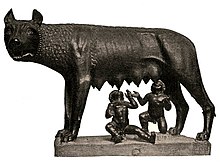|
Modern hand-made 14K Gold Pendant
This is an authentic ancient Roman coin in a
beautiful, artistic, hand-made 14 karat gold setting. This is a unique work of
art. |
|
Provided with Certificate of Authenticity. CERTIFIED AUTHENTIC Romulus and Remus are Rome's twin founders in its traditional foundation myth. They are descendants of the Trojan prince and refugee Aeneas, and are fathered by the god Mars or the demi-god Hercules on a royal Vestal Virgin, Rhea Silvia, whose uncle exposes them to die in the wild. They are found by a she-wolf who suckles and cares for them. The twins are eventually restored to their regal birthright, acquire many followers and decide to found a new city.
The legend of Romulus and Remus encapsulates Rome's ideas of itself, its origins, moral values and purpose: it has also been described as one of the most problematic of all foundation myths. Romulus' name is thought to be a back-formation from the name Rome; Remus' is a matter for ancient and modern speculation. The main sources for the legend approach it as history and offer an implausibly exact chronology: Roman historians dated the city's foundation variously from 758 to 728 BC. Plutarch says Romulus was fifty-three at his death; which reckoning gives the twins' birth year as c. 771 BC. Possible historical bases for the broad mythological narrative remain unclear and much disputed. Romulus and Remus are eminent among the feral children of ancient mythography.
Caesar Flavius Valerius
Aurelius Constantinus Augustus (27 February c. 272
– 22 May 337), commonly The Byzantine liturgical calendar, observed by the Eastern Orthodox Church and Eastern Catholic Churches of Byzantine rite, lists both Constantine and his mother Helena as saints. Although he is not included in the Latin Church's list of saints, which does recognize several other Constantines as saints, he is revered under the title "The Great" for his contributions to Christianity. Constantine also transformed the ancient Greek colony of Byzantium into a new imperial residence, Constantinople, which would remain the capital of the Byzantine Empire for over one thousand years.
The latter part of his life saw his commitment to the church rise in step with the increasing repression against old-school paganism. He left behind several sons who would, after his death, turn on each other and generally undo much of the stability that Constantine had fought so hard to bring about. |
| Payment & Shipping:
Will accept payments via PayPal. |



 known in
known in